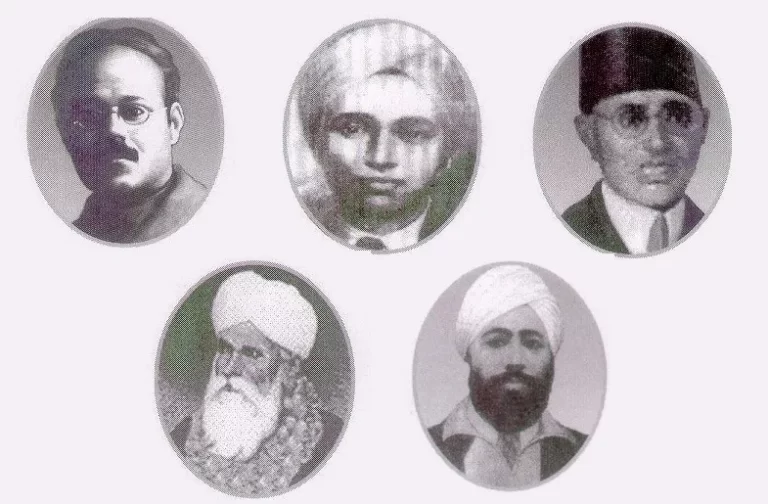
Strong anti-Indian sentiments in America caused Indian Americans to turn to the nationalist ideology of the Party. Through the Ghadar, they stressed unity between Hindus, Muslims, and Sikhs and abandonment of religious-nationalist ideology.
By Ashir Rao
It’s 1918. In a packed San Francisco district court, the public looks on with sorrow at a miscarriage of justice. Over a dozen Indians are being convicted for trying to do what the Americans had done to the British 142 years ago.
Suddenly, without warning, one of the defendants pulls out a revolver and shoots one of his comrades! Over the din of the panicked courtroom, his comrades make out the words “Traitor!” from his lips.
From Bhagat Singh’s radicalism to the non-cooperation of Mahatma Gandhi, the Indian independence movement has had numerous heroes. Their stories have been told for generations. But, another movement, a story of idealism and revolution, seems to have been left out of history and our collective imagination– the story of the Ghadarites.
Originally the “Pacific Coast Hindustan Association”, the Ghadar Party was founded by Lala Har Dayal with help from Indian immigrants and Indian students from UC Berkeley. “Ghadar” means “rebellion” in Punjabi and Urdu.
And their goal?
Armed rebellion and the deposition of the British Raj.
They set up their headquarters in San Francisco and began publishing the Hindustan Ghadar, a newspaper, to spread revolutionary ideas. To prevent information from falling into the hands of British intelligence, the names of thousands of subscribers were memorized.
Strong anti-Indian sentiments in America caused Indian Americans to turn to the nationalist ideology of the Party. Through the Ghadar, they stressed unity between Hindus, Muslims, and Sikhs and abandonment of religious-nationalist ideology. They highlighted this sentiment in a poem published in the paper:
“Though Hindus, Mussalmans, and Sikhs we be
We are sons of Bharat still
Put aside your arguments for another day
The call of the hour is to kill.”
The Ghadarites were committed to their goal. In an organized effort, hundreds of Ghadarites departed from San Francisco to India and other parts of the world to spread their ideas. They were successful in creating an underground network from the fields of Punjab to Calcutta to even Shanghai. They also worked closely with Irish Republicans, including Eamon de Valera when he was in America.
Together, they hatched a daring plan. On 21st February 1915, they would trigger a mutiny among the Indian soldiers stationed in India. It would start with the 23rd and 26th Punjabi Cavalry, who were infiltrated by Ghadarites. They would overwhelm their British commanders and form a revolutionary army. With their superior cavalry speed, they would swiftly take Lahore and seize Punjab. Then, they would march on to Delhi with help from the newly liberated Indians. The soldiers in Bengal would check for the Punjab Mail the following day. If it didn’t arrive, it would signal that Punjab had been liberated and they would begin a mutiny in Bengal.
But unfortunately, they weren’t careful enough. British intelligence had infiltrated their ranks. One of the cousins of a soldier in the 23rd Punjab was a British agent! All the planned mutinies were put down before they could materialize. Two Ghadarites, V.G Pingle and Kartar Singh, made a last-ditch attempt to start a rebellion in the city of Meerut, but it failed. Pingle and Singh were also apprehended.
Scores of arrested revolutionaries were tried in Lahore. More surprisingly, the British crackdown reached San Francisco as well. Under intense diplomatic pressure, the US arrested and tried several Ghadarite activists in what was publicized as the “Hindu-German Conspiracy Trial” — the longest and most expensive trial in the US to date. Most were charged with “violating neutrality”. The American public, however, sided with the revolutionaries, who had frequently quoted Washington and Lincoln in the Ghadar.
Unsurprisingly, most defendants were found “guilty”. The trial was criticized as rigged to appease the British government.
On the last day of the trial, Ram Chandra, editor of the Ghadar was shot by one of his comrades out of suspicion of being a traitor. The movement had collapsed.
As Napoleon once said “A revolution is an idea, taken up by bayonets”, Ghadarites were able to spark an idea of revolution and carry it across the ocean. Though crushed by treachery, their idea lived on and continued to inspire millions of Indians that led to the eventual freedom from the British raj.
____________________
Ashir Rao is a student at Los Gatos High School, CA. He likes programming and history — especially as it relates to current events.
Courtesy: India Currents (Published on August 3, 2021)